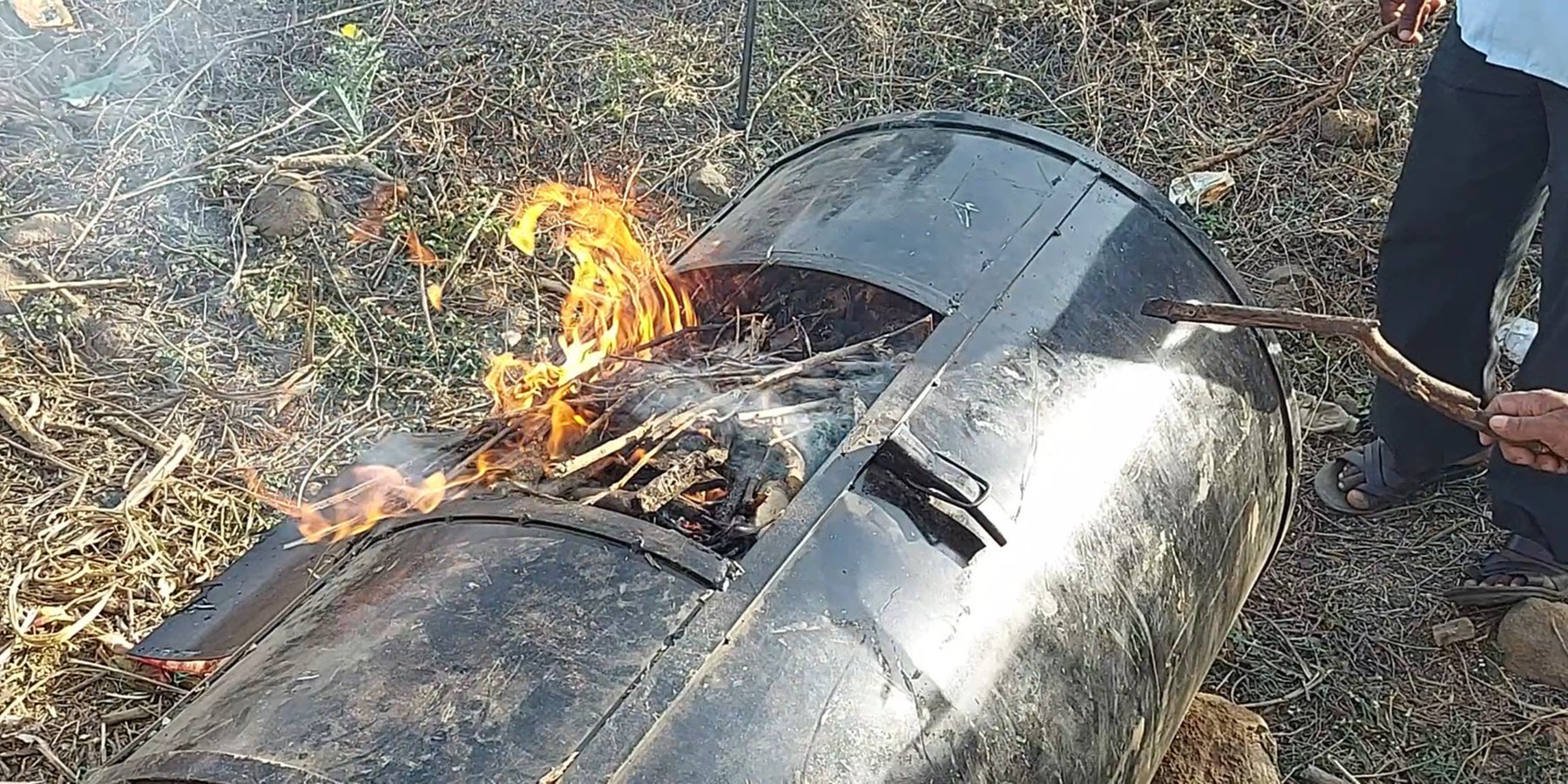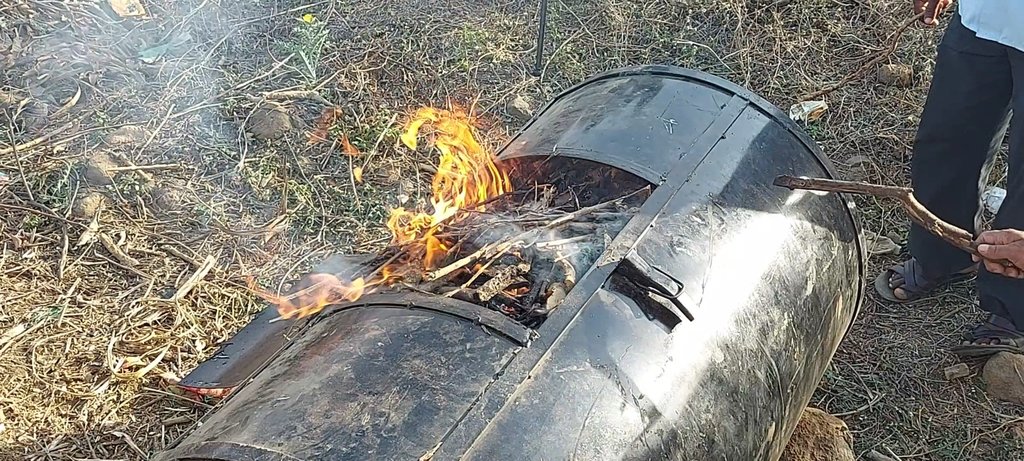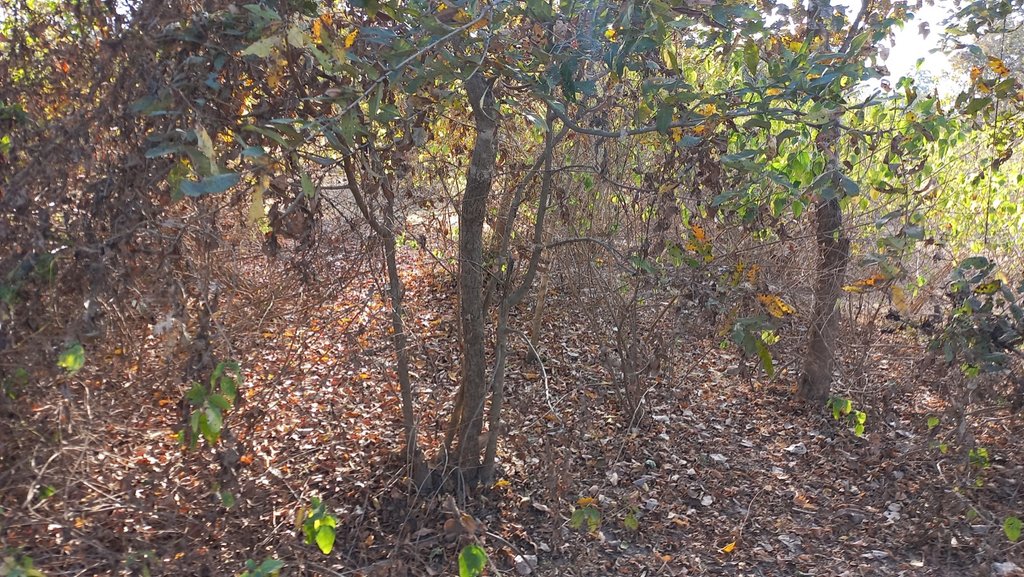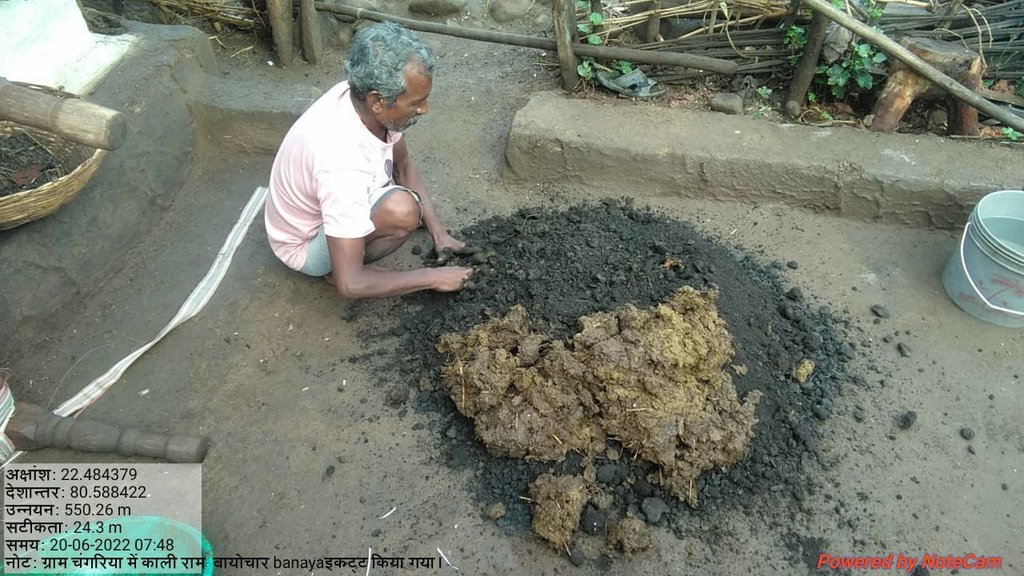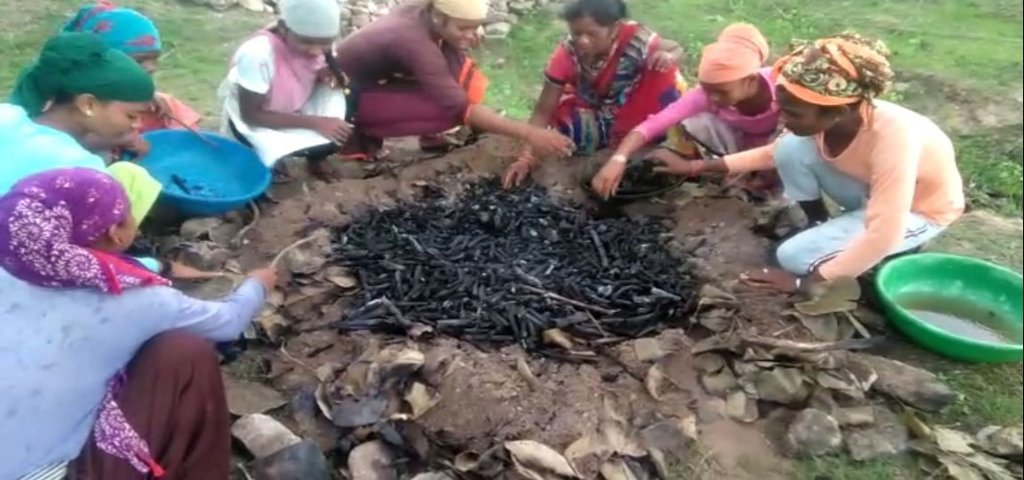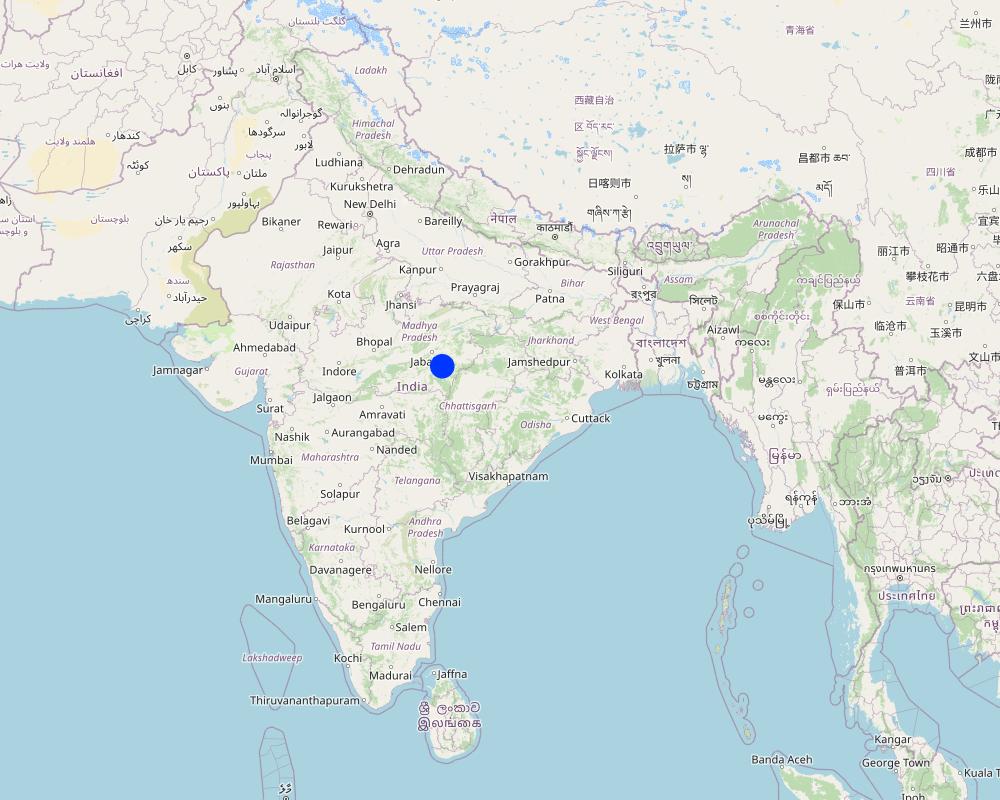Biochar Production from the Invasive Species Lantana Camara [India]
- Creación:
- Actualización:
- Compilador: Santosh Gupta
- Editores: Noel Templer, Stephanie Katsir, Kim Arora, Tabitha Nekesa, Ahmadou Gaye, Siagbé Golli
- Revisores: Udo Höggel, Joana Eichenberger, Rima Mekdaschi Studer
technologies_6690 - India
Visualizar secciones
Expandir todo Colapsar todos1. Información general
1.2 Detalles de contacto de las personas de referencia e instituciones involucradas en la evaluación y la documentación de la Tecnología
Nombre del proyecto que financió la documentación/ evaluación de la Tecnología (si fuera relevante)
Soil protection and rehabilitation for food security (ProSo(i)l)Nombre de la(s) institución(es) que facilitaron la documentación/ evaluación de la Tecnología (si fuera relevante)
Deutsche Gesellschaft für Internationale Zusammenarbeit (GIZ) GmbH (GIZ) - AlemaniaNombre de la(s) institución(es) que facilitaron la documentación/ evaluación de la Tecnología (si fuera relevante)
Alliance Bioversity and International Center for Tropical Agriculture (Alliance Bioversity-CIAT) - KeniaNombre de la(s) institución(es) que facilitaron la documentación/ evaluación de la Tecnología (si fuera relevante)
Ecociate Consultants (Ecociate Consultants) - India1.3 Condiciones referidas al uso de datos documentados mediante WOCAT
El compilador y la/s persona(s) de referencia claves aceptan las condiciones acerca del uso de los datos documentados mediante WOCAT:
Sí
1.4 Declaración de la sostenibilidad de la Tecnología descrita
¿La Tecnología aquí descrita resulta problemática en relación a la degradación de la tierra, de tal forma que no puede considerársela una tecnología sostenible para el manejo de la tierra?
No
Comentarios:
The technology discusses one of the sustainable land management practices that rehabilitate soil health by eradicating invasive species of Lantana Camara and using it to prepare biochar.
2. Descripción de la Tecnología MST
2.1 Breve descripción de la Tecnología
Definición de la Tecnología:
Lantana Camara, an invasive species in India, negatively impacts biodiversity and agriculture. Biochar made from its biomass can help manage the species effectively. Traditionally farmers produce biochar in soil pit kilns. Another low-cost portable kiln unit of biochar preparation is a viable option for rainfed areas, designed to work on the direct up-draft principle with bottom ignition and circular vents for uniform heat transfer.
2.2 Descripción detallada de la Tecnología
Descripción:
Lantana Camara was introduced into India as an ornamental plant in 1809 by the British in Calcutta Botanical Garden. Lantana Camara negatively impacts biodiversity and native biota, disrupting the succession cycle, altering the structure and floral composition of native communities, and causing problems in agricultural lands in various regions of India. Its dense thickets outcompete native pastures, block the movement of grazers, and can cause poisoning. Its allelopathic activities also affect the growth of other species in its proximity. One of the measures to manage invasive species is by turning it into biochar.
Biochar is the charred biomass produced by slow pyrolysis in which organic material is heated under controlled temperatures (300-500°C) without oxygen. Lantana Camara is an ideal biomass for biochar production due to its high diversity and wide distribution. In addition to protecting ecosystems, invasive plant-derived biochar has potential applications in environmental remediation and soil amendment due to its unique structure, composition, and adsorption properties.
In the Mandla district of Madhya Pradesh, low-cost technologies for producing biochar are being practised. A low-cost portable kiln unit has been used in the Mandla District to cater to the needs of small and marginal farmers. One unit costs approximately Rs. 7000-12000 depending upon the design and location, including a metal drum, vent-making charges, and side fittings. The kiln is designed to work on the direct up-draft principle with bottom ignition. It is a vertical, single-barrel structure with a perforated base. The kiln has a square-shaped loading hole at the top, which can be closed at the end of conversion with a metal lid with a handle. The kiln has circular vents, a staggered arrangement to avoid rows, and a central vent to hold a wooden pole. Under open atmospheric conditions, the vents at the kiln base hasten hot gas movement through the bio-residues for uniform heat transfer by primary air movement. The kiln's top hole vents the released water vapours and hot gases. A strip of metal is welded around at 3/4th height of the kiln, to which two metal rods are welded on opposite sides to serve as lifting jacks. Dry Lantana Camara feedstock is placed inside the kiln unit, and a fire is lit at the bottom. Through a pyrolysis process, the organic compounds present in the biomass decompose at a specific temperature in an oxygen-limited environment.
Prior to use, the stalks/twigs of lantana are manually cut into appropriate pieces 15-19 cm long and 0.9-1.0 cm in diameter using a commonly used axe in order to achieve better packing density. Dry residues are a prerequisite to hasten satisfactory and quicker conversion. The dried residues of lantana are placed in the unit and are burned from the bottom in an oxygen-limited environment. Generally, the burning process takes 6-8 hours through a slow pyrolysis process. Once complete, the kiln is quenched with soil and left to cool for 3-4 hours. This simple and affordable biochar production method can help manage invasive plant species and benefit agriculture, the environment, and energy. The conversion ratio from biomass to biochar in the case of Lantana is around 20-25%. Farmers have reported of burning around 100 kg of dried Lantana biomass to get ~20 kg of biochar in one operation of the unit. The application rate of biochar varies from crop to crop and the type of soil and other characters. In studied project farmers do apply 20 kg of biochar mixed with 20 kg of cow dung and 20 kg of cow urine in an area of around 1 acre.
The burned biomass of Lantana after the process looks like the coal sticks, these sticks are pulverised through a pulveriser to make a powdered material for application in the field. The biochar is mixed with an equal quantity of cow dung and cow urine before the application. Some farmers also mix the native soils in biochar to get better results.
2.3 Fotografías de la Tecnología
2.4 Videos de la Tecnología
Comentarios, descripción breve:
YouTube video accessible at https://youtu.be/MPj4_I5BFRE
2.5 País/ región/ lugares donde la Tecnología fue aplicada y que se hallan comprendidos por esta evaluación
País:
India
Región/ Estado/ Provincia:
Madhya Pradesh
Especifique más el lugar :
Mandla
Especifique la difusión de la Tecnología:
- aplicada en puntos específicos/ concentrada en un área pequeña
¿El/los sitio(s) de la Tecnología se ubica(n) en un área de protección permanente?
No
Comentarios:
Farmers from the Mandla District of Madhya Pradesh State in India use the cost-effective technology of biochar preparation from Lantana Camara.
Map
×2.6 Fecha de la implementación
Indique año de implementación:
2020
2.7 Introducción de la Tecnología
Especifique cómo se introdujo la Tecnología:
- durante experimentos/ investigación
- mediante proyectos/ intervenciones externas
Comentarios (tipo de proyecto, etc.):
FES has worked effectively with the community to eradicate Lantana Camera from private and common land and use it for the preparation of biochar
3. Clasificación de la Tecnología MST
3.1 Propósito(s) principal(es) de la Tecnología MST
- mejorar la producción
- reducir, prevenir, restaurar la degradación de la tierra
- conservar el ecosistema
- preservar/ mejorar biodiversidad
- crear impacto económico benéfico
3.2 Tipo(s) actuales de uso de la tierra donde se aplica la Tecnología
Mezcla de tipos de uso de tierras dentro de la misma unidad de tierras: :
Sí
Especifique el uso combinado de tierras (cultivos/ pastoreo/ árboles):
- Agroforestería

Tierras cultivadas
- Cosecha anual
Cosechas anuales - Especifique cultivos:
- cereales - mijo
- vegetales - otros
- Fallow - maize/sorghum/millet
Número de temporadas de cultivo por año:
- 2
¿Se practica el intercultivo?
Sí
Si respondió que sí, especifique qué cultivos son intercultivados:
Millets, Mustard, Mixed Vegetables, Maize
¿Se practica la rotación de cultivos?
Sí
Si fuera el caso, especifique :
Maize-Mustard/Wheat

Tierra de pastoreo
Pastoreo extenso:
- Pastoralismo trashumante
Pastoreo intensivo/ producción de forraje:
- Cortar y llevar/ cero pastoreo
Tipo de animal:
- búfalos
- ganado - lechero
- cabras
¿Se practica el manejo integrado de cultivos - ganado?
No

Bosques
- Bosques/ zonas boscosas (semi) naturales
Bosques/ zonas boscosas (semi-) naturales: Especifique tipo de manejo:
- Eliminación de madera muerta/ de poda
- Uso de productos forestales no madereros
¿Los árboles especificados son deciduos o imperecederos?
- mixto deciduo/ imperecedero
Productos y servicios:
- Madera
- Leña
- Frutos y nueces
- Otros productos forestales
- Pastoreo/ ramoneo
- Conservación/ Protección de la naturaleza
Comentarios:
Lantana camara is a highly invasive plant species that can quickly spread and take over private and common land. The plant can spread rapidly by seeds or vegetative propagation, and it can grow in various environments. This makes it difficult to control once it has established itself in an area. Lantana Camara outcompetes native plant species, reduces biodiversity and alters ecosystem processes. Additionally, the plant can be toxic to livestock and wildlife, and its dense growth can increase the wildfire risk.
3.3 ¿Cambió el uso de tierras debido a la implementación de la Tecnología?
¿Cambió el uso de tierras debido a la implementación de la Tecnología?
- No (Continúe con la pregunta 3.4)

Otros
Especifique:
Removal of Lantana and making use of its biomass for preparation of biochar
Comentarios:
In the case of Lantana Camara, making biochar from the plant material can help to prevent the spread of the invasive species while also producing a helpful product. Biochar has many potential uses, including as a soil amendment, a carbon sequestration tool, and a renewable energy source.
3.4 Provisión de agua
Provisión de agua para la tierra donde se aplica la Tecnología:
- de secano
Comentarios:
Approximately 9% of the net area sown has some source of irrigation, rest is rainfed (Source, CGWB, 2013). Significantly used sources of irrigation are canals, dug well, and tanks/ponds.
3.5 Grupo MST al que pertenece la Tecnología
- manejo de bosques naturales y seminaturales:
- agroforestería
- cobertura de suelo/ vegetal mejorada
3.6 Medidas MST que componen la Tecnología

medidas agronómicas
- A2: materia orgánica/ fertilidad del suelo

medidas vegetativas
- V4:reemplazo o eliminación de especies extrañas/ invasoras

medidas de manejo
- M1: Cambio de tipo de uso de la tierra
- M5: Control/ cambio de composición de las especies
3.7 Principales tipos de degradación de la tierra encarados con la Tecnología

deterioro físico del suelo
- Ps: hundimiento de suelos orgánicos, asentamiento del suelo
- Pu: pérdida de la función bioproductiva a causa de otras actividades

degradación biológica
- Bc: reducción de la cobertura vegetal del suelo
- Bh: pérdida de hábitats
- Bf: efectos nocivos de los fuegos
3.8 Prevención, reducción o restauración de la degradación de la tierra
Especifique la meta de la Tecnología con relación a la degradación de la tierra:
- prevenir la degradación de la tierra
- reducir la degradación de la tierra
Comentarios:
The application of biochar improves soil health by improving the soil's organic carbon and enhancing the soil's water-holding capacity
4. Especificaciones técnicas, actividades de implementación, insumos y costos
4.1 Dibujo técnico de la Tecnología
Especificaciones técnicas (relacionadas al dibujo técnico):
Drawing of the biochar kiln developed by the expert agency
4.2 Información general sobre el cálculo de insumos y costos
Especifique cómo se calcularon los costos e insumos:
- por área de Tecnología
otra / moneda nacional (especifique):
INR
Si fuera relevante, indique la tasa de cambio de dólares americanos a la moneda local (ej. 1 U$ = 79.9 Reales Brasileros): 1 U$ =:
80,0
Indique el costo promedio del salario de trabajo contratado por día:
204
4.3 Actividades de establecimiento
| Actividad | Momento (estación) | |
|---|---|---|
| 1. | Pyrolysis of Biomass (Lantana camara) in Biochar kiln unit | October-November and June-July (Before the winter and monsoon cropping seasons). |
| 2. | Pulverisation of coal sticks received after the Pyrolysis process | October-November/June-July (Immediately after the Pyrolysis process ) |
Comentarios:
The availability of moisture in the soil makes the uprooting/removal of Lantana camara easy, that's the reason behind its removal in the post-monsoon season. Biochar is produced by the farmers just before the cropping seasons. Monsoon (Known as Kharif) and Winter (Known as Rabi) are the most dominant cropping seasons in India.
The establishment cost of a biochar production Kiln is low, as it is specially designed for small and marginal farmers. The unit once purchased can be used for 8-10 years with a very low maintenance cost.
4.4 Costos e insumos necesarios para el establecimiento
| Especifique insumo | Unidad | Cantidad | Costos por unidad | Costos totales por insumo | % de los costos cubiertos por los usuarios de las tierras | |
|---|---|---|---|---|---|---|
| Equipo | Biochar Kiln | Number | 1,0 | 7000,0 | 7000,0 | 25,0 |
| Equipo | Pulverizer unit | Number | 1,0 | 20000,0 | 20000,0 | 25,0 |
| Costos totales para establecer la Tecnología | 27000,0 | |||||
| Costos totales para establecer la Tecnología en USD | 337,5 | |||||
Si el usuario de la tierra no cubrió el 100% de los costos, indique quién financió el resto del costo:
The remaining cost is being covered by the project funds routed through community organisations
Comentarios:
The design of the biochar kiln is simple, there is hardly any cost involved in maintaining the unit. Labour cost is required generally for the removal of Lantana Camara and for the preparation of the biochar. Exact costs cannot be indicated at this time.
4.5 Actividades de establecimiento/ recurrentes
| Actividad | Momento/ frequencia | |
|---|---|---|
| 1. | Preparation of Biochar | Before the sowing of Rabi and Kharif season (Month of October/November and June/July) |
| 2. | Application of Biochar in the field | During the crops seasons; |
Comentarios:
No maintainance cost is involved in preparing biochar from Lantana Camara, as the design of the kiln is straightforward and cost-effective. Preventing the regrowth of Lantana Camara in the areas where it is removed is the only monitoring factor involved at regular intervals.
4.6 Costos e insumos necesarios para actividades de mantenimiento/ recurrentes (por año)
| Especifique insumo | Unidad | Cantidad | Costos por unidad | Costos totales por insumo | % de los costos cubiertos por los usuarios de las tierras | |
|---|---|---|---|---|---|---|
| Mano de obra | Labor cost for removal of lantana | ha | 1,0 | 5000,0 | 5000,0 | 25,0 |
| Mano de obra | Preparation of biochar | Person-day | 2,0 | 200,0 | 400,0 | 100,0 |
| Mano de obra | Application of biochar in the field | Person-day | 0,5 | 200,0 | 100,0 | 100,0 |
| Mano de obra | Transportation of lantana | Trip | 1,0 | 200,0 | 200,0 | 100,0 |
| Fertilizantes y biocidas | Cow dung | kg | 20,0 | 5,0 | 100,0 | 100,0 |
| Fertilizantes y biocidas | Cow urine | kg | 20,0 | 5,0 | 100,0 | 100,0 |
| Indique los costos totales para mantenecer la Tecnología | 5900,0 | |||||
| Costos totales para mantener la Tecnología en USD | 73,75 | |||||
Comentarios:
Recurring cost includes removing the lantana and preparing biochar, and cow dung and cow urine must be mixed with biochar before application in the field. In most cases, family members are engaged as labour.
4.7 Factores más determinantes que afectan los costos:
Describa los factores más determinantes que afectan los costos:
Cost of the biochar kiln
5. Entorno natural y humano
5.1 Clima
Lluvia anual
- < 250 mm
- 251-500 mm
- 501-750 mm
- 751-1,000 mm
- 1,001-1,500 mm
- 1,501-2,000 mm
- 2,001-3,000 mm
- 3,001-4,000 mm
- > 4,000 mm
Especifique el promedio anual de lluvia (si lo conoce), en mm:
1427,00
Especificaciones/ comentarios sobre la cantidad de lluvia:
Monsoon season is June-September which has the majority of the rainfall
Indique el nombre de la estación metereológica de referencia considerada:
District at Glance report of Ministry of Water Resources, Central Groundwater Board, North Central Region BHOPAL, 2013
Zona agroclimática
- Sub-húmeda
- semi-árida
The National Bureau of Soil Survey & Land Use Planning (NBSS&LUP) developed twenty agroecological zones based on the growing period as an integrated criterion of adequate rainfall and soil groups. It delineated boundaries adjusted to district boundaries with a minimal number of regions. Mandla District of Madhya Pradesh lies in a Hot subhumid ecoregion with red and black soil. The part of the district also lies in a semi-arid region as these regions don't have irrigation facilities and the length of the growing period lies between 75-179 days.
Precepitation - 1000–1500mm; Potential Evapotranspiration -1300–1500 mm; Lenght of Growing Period-150–180days
5.2 Topografía
Pendientes en promedio:
- plana (0-2 %)
- ligera (3-5%)
- moderada (6-10%)
- ondulada (11-15%)
- accidentada (16-30%)
- empinada (31-60%)
- muy empinada (>60%)
Formaciones telúricas:
- meseta/ planicies
- cordilleras
- laderas montañosas
- laderas de cerro
- pies de monte
- fondo del valle
Zona altitudinal:
- 0-100 m s.n.m.
- 101-500 m s.n.m.
- 501-1,000 m s.n.m
- 1,001-1,500 m s.n.m
- 1,501-2,000 m s.n.m
- 2,001-2,500 m s.n.m
- 2,501-3,000 m s.n.m
- 3,001-4,000 m s.n.m
- > 4,000 m s.n.m
Indique si la Tecnología se aplica específicamente en:
- no relevante
Comentarios y especificaciones adicionales sobre topografía :
The project area is hilly and forested (Satpura hill range) and highly undulating with narrow strips of cultivated plains in the valley portion of the river. The plateau is in the northern part, formed by basalt and east-west trending hill in the southern region. The highest elevation is 934 m amsl in the northern part, and the lowest elevation is around 400 m amsl in the northwestern part of the area. Protected forest areas cover a large majority of the site in the district as part of the Kanha National Park.
5.3 Suelos
Profundidad promedio del suelo:
- muy superficial (0-20 cm)
- superficial (21-50 cm)
- moderadamente profunda (51-80 cm)
- profunda (81-120 cm)
- muy profunda (>120 cm)
Textura del suelo (capa arable):
- áspera/ ligera (arenosa)
- mediana (limosa)
Textura del suelo (> 20 cm debajo de la superficie):
- mediana (limosa)
- fina/ pesada (arcilla)
Materia orgánica de capa arable:
- baja (<1%)
Si se halla disponible, adjunte una descripción completa de los suelos o especifique la información disponible, por ej., tipo de suelo, pH/ acidez de suelo, capacidad de intercambio catiónico, nitrógeno, salinidad, etc. :
Soil Testing Parameter status (Average) 2017-20 for the project areas is as follows. This data is based on the soil samples tested by the FES in its soil labs from the project villages.
Soil pH:- 5.906548628; EC (electrical conductivity):- 0.122993577; Soil Organic Carbon:- 0.83%; Nitrogen. :- 293.3696598; Phosphorus:- 25.77762582; Potassium (K):- 139.6696636; Sulphur (S):-18.93457993; Zinc (Zn):- 0.955246706; Boron (Bn):- 0.490850376
5.4 Disponibilidad y calidad de agua
Agua subterránea:
5-50 m
Disponibilidad de aguas superficiales:
mediana
Calidad de agua (sin tratar):
agua potable de mala calidad (requiere tratamiento)
La calidad de agua se refiere a:
agua subterránea y superficial
¿La salinidad del agua es un problema?
No
¿Se está llevando a cabo la inundación del área? :
No
Comentarios y especificaciones adicionales sobre calidad y cantidad de agua:
The groundwater status is within the safe limits as per the reports by the Government of Madhya Pradesh. People use water from rivers, streams, and traditional small wells for domestic purposes. In the absence of good vegetative cover, the rainwater washes off the fertile topsoil from the farmlands making the land barren and resulting in the siltation of ponds and other water bodies. Further, a heavy infestation of invasive species such as Lantana Camara compounds the degradation.
The studied block Bichhiya is in a better position in terms of stage of groundwater development with 17%, while the average of the district is 7%. The stage of groundwater development refers to the % of groundwater being used for various purposes from the available groundwater in that area e.g. net annual groundwater availability in Bichhiya block is 9087 ham (hectare meters) while the existing annual ground water draft for all usage is 1523 ham, making it a 17% groundwater development stage.
Source: http://cgwb.gov.in/District_Profile/MP/Mandla.pdf
5.5 Biodiversidad
Diversidad de especies:
- elevada
Diversidad de hábitats:
- elevada
Comentarios y especificaciones adicionales sobre biodiversidad:
The area is surrounded by Kanha National Park and Phen Wildlife Sanctuary, with a good presence of forest area. World famous Kanha Tiger Reserve is situated in the Mandla district. Kanha is famous for Tiger and Barasingha. Kanha has numerous species of insects, butterflies, reptiles, fishes, and other lesser life forms. Important mammals, birds, reptiles, crustaceans, amphibians, insects, mollusks, and fishes are found in Kanha National Park. The faunal diversity of the district represents 32 wild animals, 63 birds, 4 fishes, and 9 reptile species, respectively. Regarding floral diversity, out of 1006 plant species available in the district, 162 are tree species, followed by 71 species of shrubs, 681 species of herbs, 51 species of climbers, 39 species of grasses, and 2 species of parasites. Mandla is richer in herbaceous species than other adjoining districts like Jabalpur and Seoni.
Source:- Documentation of Biodiversity Status in Mandla District of Madhya Pradesh https://mpsbb.mp.gov.in/completedProject/MB.pdf
5.6 Las características de los usuarios de la tierra que aplican la Tecnología
Sedentario o nómada:
- Sedentario
Orientación del mercado del sistema de producción:
- mixta (subsistencia/ comercial)
Ingresos no agrarios:
- > 50% de todo el ingreso
Nivel relativo de riqueza:
- pobre
- promedio
Individuos o grupos:
- individual/ doméstico
- grupos/ comunal
Nivel de mecanización:
- trabajo manual
- tracción animal
Género:
- mujeres
- hombres
Edad de los usuarios de la tierra:
- jóvenes
- personas de mediana edad
Indique otras características relevantes de los usuarios de las tierras:
The large majority of the user belong to the tribal community, including some households from an ethnic community called Baiga.
https://en.wikipedia.org/wiki/Baiga_tribe
5.7 Área promedio de la tierra usada por usuarios de tierra que aplican la Tecnología
- < 0.5 ha
- 0.5-1 ha
- 1-2 ha
- 2-5 ha
- 5-15 ha
- 15-50 ha
- 50-100 ha
- 100-500 ha
- 500-1,000 ha
- 1,000-10,000 ha
- > 10,000 ha
¿Esto se considera de pequeña, mediana o gran escala (refiriéndose al contexto local)?
- pequeña escala
5.8 Tenencia de tierra, uso de tierra y derechos de uso de agua
Tenencia de tierra:
- comunitaria/ aldea
- individual, con título
Derechos de uso de tierra:
- individual
Derechos de uso de agua:
- comunitarios (organizado)
- individual
¿Los derechos del uso de la tierra se basan en un sistema legal tradicional?
Sí
Especifique:
The concerned authorities have issued landowners the land certificates.
5.9 Acceso a servicios e infraestructura
salud:
- pobre
- moderado
- bueno
educación:
- pobre
- moderado
- bueno
asistencia técnica:
- pobre
- moderado
- bueno
empleo (ej. fuera de la granja):
- pobre
- moderado
- bueno
mercados:
- pobre
- moderado
- bueno
energía:
- pobre
- moderado
- bueno
caminos y transporte:
- pobre
- moderado
- bueno
agua potable y saneamiento:
- pobre
- moderado
- bueno
servicios financieros:
- pobre
- moderado
- bueno
6. Impactos y comentarios para concluir
6.1 Impactos in situ demostrados por la Tecnología
Impactos socioeconómicos
Producción
producción de cultivo
Comentarios/ especifique:
Approximately increase of 15-20% across the crops. Where biochar was used, since this has happened in multiple commodities specifying the number for any crop will not do justice.
calidad de cultivo
Comentarios/ especifique:
Grain size, the strength of biomass and overall taste of the grains. These are the qualitative measures which can not be addressed in numbers.
manejo de tierras
Disponibilidad y calidad de agua
disponibilidad de agua para irrigar
Comentarios/ especifique:
Biochar maintains soil moisture thus, farmers need to use less quantity of water for irrigation.
Impactos socioculturales
MST/ conocimiento de la degradación de la tierra
Impactos ecológicos
Biodiversidad: vegetación, animales
Cubierta vegetal
Comentarios/ especifique:
Lantana Camara negatively impacts biodiversity and native biota. Its dense thickets outcompete native pastures, blocks the movement of grazers, and can cause poisoning. Its eradication helps improving the vegetative cover.
diversidad vegetal
Comentarios/ especifique:
As the density of Lantana Camara in the forest increases, allelopathic interactions increase, and hence, species richness declines (Day et al., 2003).
especies invasoras extrañas
Comentarios/ especifique:
The invasive alien species of Lantana Camara are removed from private and common land.
diversidad animal
diversidad de hábitats
Reducción de riesgos de desastres y riesgos climáticos
riesgo de incendio
6.2 Impactos fuera del sitio demostrados por la Tecnología
disponibilidad de agua
6.4 Análisis costo-beneficio
¿Cómo se comparan los beneficios con los costos de establecimiento (desde la perspectiva de los usuarios de tierra)?
Ingresos a corto plazo:
positivo
Ingresos a largo plazo:
muy positivo
¿Cómo se comparan los beneficios con los costos de mantenimiento/ recurrentes (desde la perspectiva de los usuarios de tierra)?
Ingresos a corto plazo:
ligeramente positivo
Ingresos a largo plazo:
muy positivo
Comentarios:
The cost of biochar production is almost negligible for farmers as it is made using local resources, while the benefits are multifold in terms of crop production, quality, and soil health improvement.
6.5 Adopción de la Tecnología
- 1-10%
De todos quienes adoptaron la Tecnología, ¿cuántos lo hicieron espontáneamente, por ej. sin recibir nada de incentivos/ materiales:
- 0-10%
Comentarios:
A number of farmers adopted the technology without any financial support from the project
6.6 Adaptación
¿La tecnología fue modificada recientemente para adaptarse a las condiciones cambiantes?
Sí
otros (especifique):
Technology
Especifique la adaptación de la Tecnología (diseño, material/ especies, etc.):
Several farmers adopted biochar production using a traditional method of digging a pit and preparing the biochar.
6.7 Fuerzas/ ventajas/ oportunidades de la Tecnología
| Fuerzas/ ventajas/ oportunidades desde la perspectiva del usuario de la tierra |
|---|
| Communities have found biochar as an essential input to meet the nutrient requirement of their soil. They have improved the quality of their farm produce by applying biochar. |
| Preparation of Biochar using Lantana Camara has emerged as an excellent use for the invasive species, which otherwise was not having any use and was growing like fire in the area |
| Improved production of the farm produce |
| Fuerzas/ ventajas/ oportunidades desde la perspectiva del compilador o de otra persona de referencia clave |
|---|
| Biochar is an excellent input for improving soil organic carbon. It can lead to healthy soil with an improved capacity of the soil to sequester carbon. |
| Over the years, soils have degraded to a great extent in the project geography. Biochar can reverse this process. |
| Farmers can grow short-duration crops and fodder for their animals in a rainfed area, with improved soil moisture. This will help improve farmers' income. |
6.8 Debilidades/ desventajas/ riesgos de la Tecnología y formas de sobreponerse a ellos
| Debilidades/ desventajas/ riesgos desde la perspectiva del usuario de la tierra | ¿Cómo sobreponerse a ellas? |
|---|---|
| The capacity of existing biochar kiln units is limited, and farmers have to wait for their turn | More units can be mobilized with community-based engagement and support from externally funded projects |
| Hard work and a long process involved uprooting lantana, drying, transportation, burning, and application | Communities need handholding and training about its importance and more technological advances |
| Debilidades/ desventajas/ riesgos desde la perspectiva del compilador o de otra persona de referencia clave | ¿Cómo sobreponerse a ellas? |
|---|---|
| In the long run, the easy accessibility of Lantana may be a concern if it is implemented on a large scale. The availability of other biomass is very much limited. | An assessment of the availability of Lantana and its annual requirement for biochar preparation can be done |
| Biochar has long-term benefits, while communities look for short-term solutions | Handholding the communities along with linking them with carbon credit-related projects may be a good option to keep farmers motivated |
| Regular application of biochar over the years | Regular communication with farmers about the positive outcome aligned with other financial incentives linked to soil organic carbon improvement |
7. Referencias y vínculos
7.1 Métodos/ fuentes de información
- visitas de campo, encuestas de campo
1
- entrevistas con usuarios de tierras
10
- compilación de informes y otra documentación existente
3
¿Cuándo se compilaron los datos (en el campo)?
22/02/2023
Comentarios:
During the field visit, detailed discussions were held with the project implementing agency, communities, and other stakeholders to understand the process and impact of the intervention.
7.2 Vínculos a las publicaciones disponibles
Título, autor, año, ISBN:
Invasive plants as potential sustainable feedstocks for biochar production and multiple applications: A review, Qianwei Feng a, Bing Wang a b c, Miao Chen a b c, Pan Wu a b c, Xinqing Lee d, Ying Xing e
¿Dónde se halla disponible? ¿Costo?
https://doi.org/10.1016/j.resconrec.2020.105204
Título, autor, año, ISBN:
Biochar for Soil Health Enhancement and Crop Productivity Improvement, Awtar Singh1*, A.P. Singh2, V. Singh1, Arijit Barman1, Sagar Vibhute1 and R.S. Tolia
¿Dónde se halla disponible? ¿Costo?
Innovative Farming, 1(4): 137-140, 2016
Título, autor, año, ISBN:
A review of Lantana camara studies in India, Neena Priyanka*,**, P. K. Joshi*
¿Dónde se halla disponible? ¿Costo?
International Journal of Scientific and Research Publications, Volume 3, Issue 10, October 2013 ISSN 2250-3153
Título, autor, año, ISBN:
Annual Progress Report on Promotion of Biochar in Mandla, developed by FES for the year 2021-22
¿Dónde se halla disponible? ¿Costo?
Internal document of FES, shared as part of the project report to GIZ. This document can be obtained from the GIZ office, India
7.3 Vínculos a la información relevante disponible en línea
Título/ descripción:
District at a glance by Central Ground Water Board
URL:
http://cgwb.gov.in/District_Profile/MP/Mandla.pdf
Título/ descripción:
Low cost Kiln for Biochar Production
URL:
http://www.nicra-icar.in/nicrarevised/images/Home/NICRA%20Technical%20Brochure%20Portable%20Kiln.pdf
Título/ descripción:
Baiga Tribes
URL:
https://en.wikipedia.org/wiki/Baiga_tribe
Título/ descripción:
Biochar on soil properties and crop performance
URL:
https://www.indiascienceandtechnology.gov.in/research/biochar-soil-properties-and-crop-performance
Título/ descripción:
Video by FES on Biochar production (Hindi)
URL:
https://www.youtube.com/watch?v=MPj4_I5BFRE
Título/ descripción:
A review of Lantana camara studies in India
URL:
https://www.ijsrp.org/research-paper-1013/ijsrp-p2207.pdf
Título/ descripción:
Low Cost Portable Kiln for Biochar Production
URL:
http://www.nicra-icar.in/nicrarevised/images/Home/NICRA%20Technical%20Brochure%20Portable%20Kiln.pdf
Vínculos y módulos
Expandir todo Colapsar todosVínculos
No hay vínculos
Módulos
No se hallaron módulos


